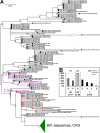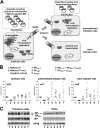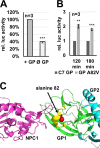Functional Characterization of Adaptive Mutations during the West African Ebola Virus Outbreak
- PMID: 27847361
- PMCID: PMC5215343
- DOI: 10.1128/JVI.01913-16
Functional Characterization of Adaptive Mutations during the West African Ebola Virus Outbreak
Abstract
The Ebola virus (EBOV) outbreak in West Africa started in December 2013, claimed more than 11,000 lives, threatened to destabilize a whole region, and showed how easily health crises can turn into humanitarian disasters. EBOV genomic sequences of the West African outbreak revealed nonsynonymous mutations, which induced considerable public attention, but their role in virus spread and disease remains obscure. In this study, we investigated the functional significance of three nonsynonymous mutations that emerged early during the West African EBOV outbreak. Almost 90% of more than 1,000 EBOV genomes sequenced during the outbreak carried the signature of three mutations: a D759G substitution in the active center of the L polymerase, an A82V substitution in the receptor binding domain of surface glycoprotein GP, and an R111C substitution in the self-assembly domain of RNA-encapsidating nucleoprotein NP. Using a newly developed virus-like particle system and reverse genetics, we found that the mutations have an impact on the functions of the respective viral proteins and on the growth of recombinant EBOVs. The mutation in L increased viral transcription and replication, whereas the mutation in NP decreased viral transcription and replication. The mutation in the receptor binding domain of the glycoprotein GP improved the efficiency of GP-mediated viral entry into target cells. Recombinant EBOVs with combinations of the three mutations showed a growth advantage over the prototype isolate Makona C7 lacking the mutations. This study showed that virus variants with improved fitness emerged early during the West African EBOV outbreak.
Importance: The dimension of the Ebola virus outbreak in West Africa was unprecedented. Amino acid substitutions in the viral L polymerase, surface glycoprotein GP, and nucleocapsid protein NP emerged, were fixed early in the outbreak, and were found in almost 90% of the sequences. Here we showed that these mutations affected the functional activity of viral proteins and improved viral growth in cell culture. Our results demonstrate emergence of adaptive changes in the Ebola virus genome during virus circulation in humans and prompt further studies on the potential role of these changes in virus transmissibility and pathogenicity.
Keywords: Ebola virus; West Africa; adaptive mutations; glycoprotein; zoonotic infections.
Copyright © 2017 American Society for Microbiology.
Figures





Similar articles
-
Naturally Occurring Single Mutations in Ebola Virus Observably Impact Infectivity.J Virol. 2018 Dec 10;93(1):e01098-18. doi: 10.1128/JVI.01098-18. Print 2019 Jan 1. J Virol. 2018. PMID: 30333174 Free PMC article.
-
Sequence analysis of the L protein of the Ebola 2014 outbreak: Insight into conserved regions and mutations.Mol Med Rep. 2016 Jun;13(6):4821-6. doi: 10.3892/mmr.2016.5145. Epub 2016 Apr 15. Mol Med Rep. 2016. PMID: 27082438
-
Human Adaptation of Ebola Virus during the West African Outbreak.Cell. 2016 Nov 3;167(4):1079-1087.e5. doi: 10.1016/j.cell.2016.10.013. Cell. 2016. PMID: 27814505 Free PMC article.
-
Ebolavirus Evolution: Past and Present.PLoS Pathog. 2015 Nov 12;11(11):e1005221. doi: 10.1371/journal.ppat.1005221. eCollection 2015. PLoS Pathog. 2015. PMID: 26562671 Free PMC article. Review.
-
Ebola virus disease and the veterinary perspective.Ann Clin Microbiol Antimicrob. 2015 May 28;14:30. doi: 10.1186/s12941-015-0089-x. Ann Clin Microbiol Antimicrob. 2015. PMID: 26018030 Free PMC article. Review.
Cited by
-
N123I mutation in the ALV-J receptor-binding domain region enhances viral replication ability by increasing the binding affinity with chNHE1.PLoS Pathog. 2024 Feb 7;20(2):e1011928. doi: 10.1371/journal.ppat.1011928. eCollection 2024 Feb. PLoS Pathog. 2024. PMID: 38324558 Free PMC article.
-
Natural history of Ebola virus disease in rhesus monkeys shows viral variant emergence dynamics and tissue-specific host responses.Cell Genom. 2023 Nov 21;3(12):100440. doi: 10.1016/j.xgen.2023.100440. eCollection 2023 Dec 13. Cell Genom. 2023. PMID: 38169842 Free PMC article.
-
Host-Pathogen Interactions Influencing Zoonotic Spillover Potential and Transmission in Humans.Viruses. 2023 Feb 22;15(3):599. doi: 10.3390/v15030599. Viruses. 2023. PMID: 36992308 Free PMC article. Review.
-
Linked Mutations in the Ebola Virus Polymerase Are Associated with Organ Specific Phenotypes.Microbiol Spectr. 2023 Mar 22;11(2):e0415422. doi: 10.1128/spectrum.04154-22. Online ahead of print. Microbiol Spectr. 2023. PMID: 36946725 Free PMC article.
-
Molecular adaptations during viral epidemics.EMBO Rep. 2022 Aug 3;23(8):e55393. doi: 10.15252/embr.202255393. Epub 2022 Jul 18. EMBO Rep. 2022. PMID: 35848484 Free PMC article. Review.
References
-
- Kuhn JH, Andersen KG, Baize S, Bào Y, Bavari S, Berthet N, Blinkova O, Brister JR, Clawson AN, Fair J, Gabriel M, Garry RF, Gire SK, Goba A, Gonzalez JP, Günther S, Happi CT, Jahrling PB, Kapetshi J, Kobinger G, Kugelman JR, Leroy EM, Maganga GD, Mbala PK, Moses LM, Muyembe-Tamfum JJ, N′Faly M, Nichol ST, Omilabu SA, Palacios G, Park DJ, Paweska JT, Radoshitzky SR, Rossi CA, Sabeti PC, Schieffelin JS, Schoepp RJ, Sealfon R, Swanepoel R, Towner JS, Wada J, Wauquier N, Yozwiak NL, Formenty P. 2014. Nomenclature- and database-compatible names for the two Ebola virus variants that emerged in Guinea and the Democratic Republic of the Congo in 2014. Viruses 6:4760–4799. doi:10.3390/v6114760. - DOI - PMC - PubMed
-
- WHO Ebola Response Team, Agua-Agum J, Ariyarajah A, Aylward B, Blake IM, Brennan R, Cori A, Donnelly CA, Dorigatti I, Dye C, Eckmanns T, Ferguson NM, Formenty P, Fraser C, Garcia E, Garske T, Hinsley W, Holmes D, Hugonnet S, Iyengar S, Jombart T, Krishnan R, Meijers S, Mills HL, Mohamed Y, Nedjati-Gilani G, Newton E, Nouvellet P, Pelletier L, Perkins D, Riley S, Sagrado M, Schnitzler J, Schumacher D, Shah A, Van Kerkhove MD, Varsaneux O, Wijekoon Kannangarage N. 2015. West African Ebola epidemic after one year—slowing but not yet under control. N Engl J Med 372:584–587. doi:10.1056/NEJMc1414992. - DOI - PMC - PubMed
-
- WHO. 2015. Ebola situation report. http://www.who.int/csr/disease/ebola/situation-reports/archive/en.
MeSH terms
Substances
LinkOut - more resources
Full Text Sources
Other Literature Sources
Medical
Miscellaneous


